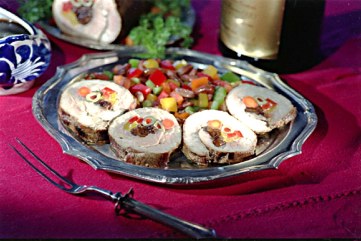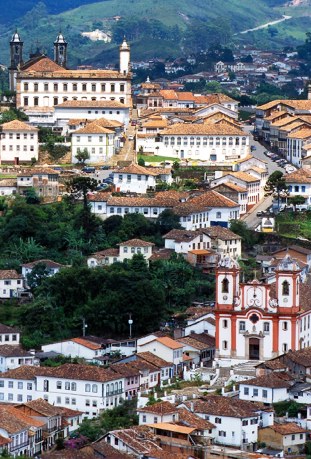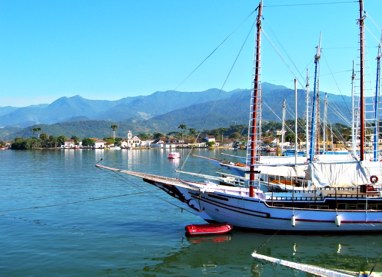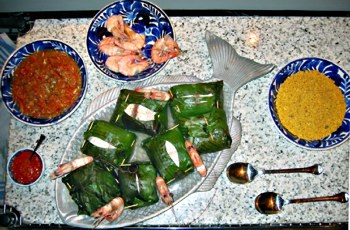Often photographed, the Copacabana in Rio has become the most instantly recognizable beach in the world. For many, this city within a city of shops, nightclubs, restaurants, theaters, and beach, is Rio. Although a little aged and somewhat tawdry from a few years of hard times, the Copacabana still has the look.
From morning to night, stunning bodies, scantily dressed, lie in the sun, play, swim, and prowl on miles of beach, which curves irresistibly in front of five-star hotels and luxury condominiums. Trendy nightclubs and restaurants in the Copacabana and its neighboring areas offer visitors the hedonistic pleasures they so relentlessly seek. If they have doubts, the friendly cariocas (locals), hawking everything from bird kites to themselves, will be happy to prove it to them.
The flipside to all this pleasure and luxury is the favela (shanty town). Known as Rocinha, the infamous slum climbs the mountain behind the Copacabana. Like the Copacabana, it too is a city within a city, but unlike the Copacabana, Rocinha is an overcrowded anthill of narrow streets and alleys with no sewers and deplorable health conditions. Inhabited by drug dealers and laborers, and threatened during the rainy season by landslides, it is hardly a picture postcard site. But gazing up at it from the Copacabana, it looks like an attractive and colorful mosaic amidst grey rock and green trees.
Observing Rio with outstretched arms, on a two-thousand-foot high summit, is the Cristo Redentor. The imposing, eye-catching statue of Christ reminds cariocas and visitors of Brazil’s deeply religious soul. Visible day or night from almost anywhere within Rio, the one-hundred-foot-high statue sits on its lofty pedestal (Corcovado) and, from its pinnacle, offers sightseers a breath-taking view of the Sugar Loaf and the Copacabana and Ipanema beaches.
For those visiting Rio during carnival, the party begins promptly when the mayor gives the city keys to Rei Momo, the king of carnival and Lord of Misrule. From that moment on, until the start of Lent, it is one wild, supersonic, five-day, 24-hour blast off of sound and movement, a happy, devil-may-care kaleidoscope of colorfully costumed and painted party-goers – drinking and sinning non-stop.
Amidst all this partying is the music – a fusion of race and culture – from hip-to-hip forró to samba-rock. During Mardi gras, and throughout the year, the rhythmic sounds fill the air. But it is during carnival that the music reaches its crescendo, and the hottest musical fashions explode everywhere accompanied by floats and motion and song.
No matter when you visit, Rio is the place to be – for sun, fun, and, especially, food. Finding good food (and drink, from tropical fruit juices, suco, to Brazil’s personality-altering alcohol cachaça) isn’t difficult. Food is another Brazilian passion.
A large and ethnically diverse country, each region of Brazil provides food lovers with a special selection of food that is tastily seasoned without being too fiery. In parts of the south, for example, there is the German influence; in São Paulo, the Italian and Japanese influence; and in Bahia, the African influence. The most traditional foods, though, are adaptations of Portuguese and African recipes.
Most Brazilian cooking is home-style, done in a single pot, and served at room temperature, which makes it perfect for entertaining. For those who enjoy fire, molho apimentado (a table sauce) can be added. To truly enjoy the food and the spirit of the eating experience, the food should be shared with lots of people and with Brazilian music (preferably a samba) in the background.
Foods favored among visitors are: salgadinhos (small Brazilian pastries stuffed with cheese and meets), churrasco (barbecued meats and sausages prepared at an open fire), feijoada (a meat, beans and sausage stew), and cozido (meats and vegetables -usually squash, cabbage and kale – boiled together).

Many of the ethnic dishes popular in other parts of Brazil can be enjoyed in Rio. For a memorable dining experience in Rio, the following six restaurants are recommended. They are currently popular, but like all great cities this can change suddenly. Restaurants open and close, great chefs come and go, and what was isn’t and what wasn’t is popular. It is, therefore, recommended to ask the hotel concierge for the latest update before making your reservation. When planning your evening out, remember that cariocas like to eat late (after 9 p.m.), and food servings are usually huge, oftentimes sufficient for two. The restaurants listed below can be dressy, and for Americans, not unreasonably expensive.
Antiquarius (Portuguese), Rua Aristides Espinola 19, Leblon. Telephone: 2294 1496. Antiquarius is an elegant restaurant with mirror-lined walls and expensive furnishings. Reputed to be one of Rio’s best restaurants, the Antiquarius has won several awards for its versatile classic Portuguese menu, which includes such dishes as perna de carneiro (leg of lamb) and Cascais-style seafood with rice. On Sundays, it offers its jazzed-up version of cozido.
Cipriani (Italian), Copacabana Palace Hotel, Avenida Atlântica 1702, Copacabana. Telephone: 2545-8747. This superb restaurant in this legendary hotel is considered one of the best in Rio. In addition to Italian cuisine, the Cipriani, which overlooks the swimming pool, serves excellent vegetarian options. The food suits royalty.
Hotel Inter-Continental Rio, Avenida Prefeito Mendes de Morais 222, São Conrado. Telephone: 3323 2200. The Inter-Continental along with the Caesar Park Hotel (Avenida Vieiro Souto 460, Ipanema; telephone: 2525 2525) are popular on Saturday afternoons for feijoada, a Brazilian national dish. Made with black beans, feijoada is filled with a variety of dried, salted and smoked meats – and served with many extras, including slices of orange to reduce the consequences of eating beans.
Le Saint Honoré (French), Le Méridien Hotel, Avenida Atlântica, 1020, Copacabana Leme. Telephone: 3873 8880. Le Saint Honoré offers visitors French gourmet food (such as Amazonian pintado, mackerel) and a breathtaking panoramic view of the beach from the 37th floor. Some consider Le Saint Honoré the top restaurant in Rio, if not South America.
Porcão (Brazilian), Rua Barão da Torre 218, Ipanema. Telephone: 3202-9150. Porcão is popular with Rio’s rich and famous for churrascaria, a Brazilian barbecue. Diners choose as much as they think they can eat from the salad buffet, and from waiters who move around the restaurant carrying platters of beef, chicken, and lamb. You should begin your dinner with Brazil’s national drink caipirinha, a wicked mixture of sugar cane rum, brown sugar, and lime. Porcão has seven locations.
The Academy of Cooking and Other Pleasures
Those eager to learn the art of Brazilian cooking should head to the Academy of Cooking and Other Pleasures either by the ocean in Paraty or in the Minas Gerais mountains in Ouro Preto. Both schools are run by Yara Castro Roberts, a native of Belo Horizonte, Brazil. A graduate in culinary arts from Boston University, art history from the Ecole du Louvre with a bachelor degree in education from the Sorbonne, Yara has the education to be the extraordinary gourmet cook/teacher that she has become. The daughter of a famous Brazilian chef and caterer, Yara has distinguished herself on her own in the Americas. She was featured in a video Brazilian Cuisine with Yara Roberts and was the hostess of a PBS series on important Brazilian cuisine and its cultural tradition. A lecturer at leading American universities, she has been written up in magazines and newspapers many times.

Dubbed an inexhaustible ambassador for food and other things Brazilians by The New York Times, she brings to each class she teaches the best of three worlds – French savoir-faire, Latin warmth, and American sensibility. Her cooking school program at both locations provides an introduction to gastronomy and some background information about the foods’ ethnic and regional connection to the traditions and history of Brazil.
The school in Ouro Preto (one hour by air to Belo Horizonte and another hour by car from Belo Horizonte) is located in a 17th century colonial, university town. During the gold rush in the 1700s, Ouro Preto became the richest city in the New World and the capital of Minas Gerais. Today it is a popular tourist area, which offers some of the world’s best preserved examples of colonial baroque architecture. Throughout the year, festivals and historical celebrations are held in the city.

The school in Paraty (three-and-a half hours by car from Rio) is situated in another colonial paradise. Founded in 1660, Paraty faces the sea, and is backed by mountains. During the rush for gold and diamonds in the 18th century, the city became famous and wealthy. Today it is a beautifully preserved seaside village with many mansions and estates, and narrow streets that contain hidden surprises: charming pousadas (inns), colonial houses, restaurants and art galleries. The village provides easy access to spectacular island beaches and mountain trails through rain forests that lead to waterfalls with natural pools.
Yara’s Minas Gerais program offers students seven days of classes filled with savory recipes and enriched with information on the history, art, music and literature as well as the local social customs. The classes include Minas Gerais cookery, Brazilian pastries, the Brazilian tradition of “high coffee,” and more. Some extras are a tour of Ouro Preto‚ the Baroque art museum and its architectural wonders, and the not-to-be-missed classical musicial performance of an outdoor Serenata.
The Paraty program includes boat trips and hill country visits to its core culinary experience. The three-day program offers students hands-on cooking, trips to a water-powered manioc flour mill, a hearts of palm plantation, and other pleasant distractions (candy making demonstrations and outdoor musical presentations, for example).
Price for the Ouro Preto program is now $2,295 per person single occupancy. This covers food and lodging for 6 days. Classes are held in May, September, and November.
The Paraty program costs $1,395 per person single occupancy. The price covers food and lodging for 3 days. Classes are held February through November.
Seminar participation is limited to 10 people. Sessions start on Sunday evenings in Ouro Preto and end on Friday afternoons, and in Paraty, they begin on Friday and end on Monday. Classes run three hours each day with fun-filled supportive activities afterwards. Program costs are exclusive of airfare and include transfers from airport to hotel, all sessions, events, field trips, print materials, hotel accommodations, breakfasts and gourmet meals.
Pork Roast Vila Rica Style
Pork Roast Vila Rica style is an elegant Minas Gerais dish, which is perfect for special occasions. It dates back to 1808 when gold was abundant and King Dom João VI of Portugal and his court relocated to Brazil (fleeing Napoleon). Elevated from a Portuguese colony to a commonwealth, Brazil was now able to obtain ingredients that were unavailable before like dried fruits, spices, and Porto and Madeira wines. The pork roast recipe is taught at Yara’s Ouro Preto school. It can be served with sautéed vegetables such as carrots, bell peppers, and white rice.
Ingredients
4 lbs. pork roast, boned
4 limes
2 tablespoons salt
1 tablespoon mustard
2 tablespoons black pepper
7 ounces apricots
7 ounces ham
1 red bell pepper, cut in 1/2 inch strip
4 ounces carrots, peeled, cut in 1/2 inch strip and cooked for 2 minutes
3 ounces olives, pitted
3 tablespoons vegetable oil
2 cups orange juice
2 onions, peeled and cut in 8 pieces
Preparation
Trim all visible fat and slivers of skin. Butterfly the meat to create a rectangular shape. Cover the meat with wax paper and pound the meat till it is 1/2 inch thick. Sprinkle with salt, black pepper, and lime juice. Cover and reserve (while preparing the ingredients)
Split the apricots in half and flatten them. Dry the meat with a paper towel and spread mustard over the pork, then cover it with ham. On top of the meat, arrange parallel lines of apricots, bell pepper, raisins, olives, and carrots. Press into the meat with your hands. Carefully roll the meat pressing down firmly.
Tie with a string. Heat oil in a cast iron pan and brown the meat on all the sides. Pour orange juice on the bottom of the pan, and add the quartered onions. Bake in the oven at 375º for 20 minutes. Cool for 10 minutes, remove the string and cut into slices. Heat the pan juices and strain. Place onions on a side dish and the juice in a bowl. Serve the slices of pork with the juice and the onions. (Serves 8)

Amazon Style Fish
Amazon Style Fish is healthy, and it makes a fabulous presentation. No side dishes are needed, when serving this fish, since it made with tomato sauce, farofa, and bananas. Inspired by Amazon cooking, it came into vogue hundreds of years ago when the Portuguese colonized Brazil. The Indian women in charge of the cooking would wrap the food in banana leaves and grill it slowly on the moquém (similar to a barbecue, but made of a wood). The fish recipe is taught at Yara’s Paraty school.
Ingredients
3 lbs. whole yellow tile, or a grouper fish, boned and open into a butterfly (head and tail still attached) or six 8 ounce fish filets
2 tablespoons salt
1/2 tablespoon black pepper
3 tablespoons lemon juice
2 tablespoons vegetable oil
1 cup chopped onions
6 garlic cloves, chopped
1/2 cup chopped cilantro
2 teaspoons Tabasco sauce or 1 Malagueta pepper crushed
1 lb. tomatoes, peeled, seeded and quartered or a 16-ounce can of whole tomatoes
2 cups fish broth
4 bananas peeled and cut lengthwise into 1/2-inch pieces
2 tablespoons olive oil or butter
4 tablespoons butter
1/2 tablespoon vegetable oil
2 tablespoons garlic, finely chopped
3 cups manioc flour
Salt and pepper
1/2 cup Brazil nuts, coarsely chopped
One 8-by-8-inch square banana leaf, if filet (found in South Asian food stores), or 6 banana-leaf squares for a whole fish.
Preparation
Wash the fish thoroughly and pat dry. Spread salt, pepper, and lemon juice over the entire fish, then place it in reserve in the refrigerator.
In a medium-size saucepan, heat the vegetable oil and sauté the onions over medium-low heat until they wilt. Then add the garlic and the chopped cilantro, mixing all ingredients together well. Season with salt and pepper. Add the tomatoes and their juices, and mix with the other ingredients. Add the fish broth and cook for 20 minutes over a low heat. Let it cool.
Heat oil and butter a in a skillet and fry the bananas 2 by 2 until light brown, then place on a plate.
In the same skillet heat the oil and butter over a low fire and sauté the garlic. Add the manioc flour by pouring it through your fingers into the skillet. Mix the flour and butter, while scraping the bottom of the pan with a spoon. Season with salt and pepper. Always mix ingredients gently. Cook until the flour becomes moist and lightly golden.
Place the fish on top of the banana leaves and open the fish. Using a spoon, cover the entire fish with the tomato sauce. Place over the fish lengthwise a mound of farofa (available in Latin American or Caribbean food markets). Sprinkle with Brazil nuts and press firmly into the fish with the hands. Place the fried bananas on top of the farofa and press gently. Carefully fold the fish toward the center. If using a whole fish, tie it with a string. Wrap the fish with the banana leaves. (If using the filet, close both sides with toothpicks.)
Place the wrapped fish in a baking dish, pour 1 cup of water on the bottom of the pan, and bake for 20 to 30 minutes in a 325 º preheated oven.
Open the banana leaves and serve with the remaining tomato sauce, farofa, and Malagueta sauce on the side. (Serves 6)
